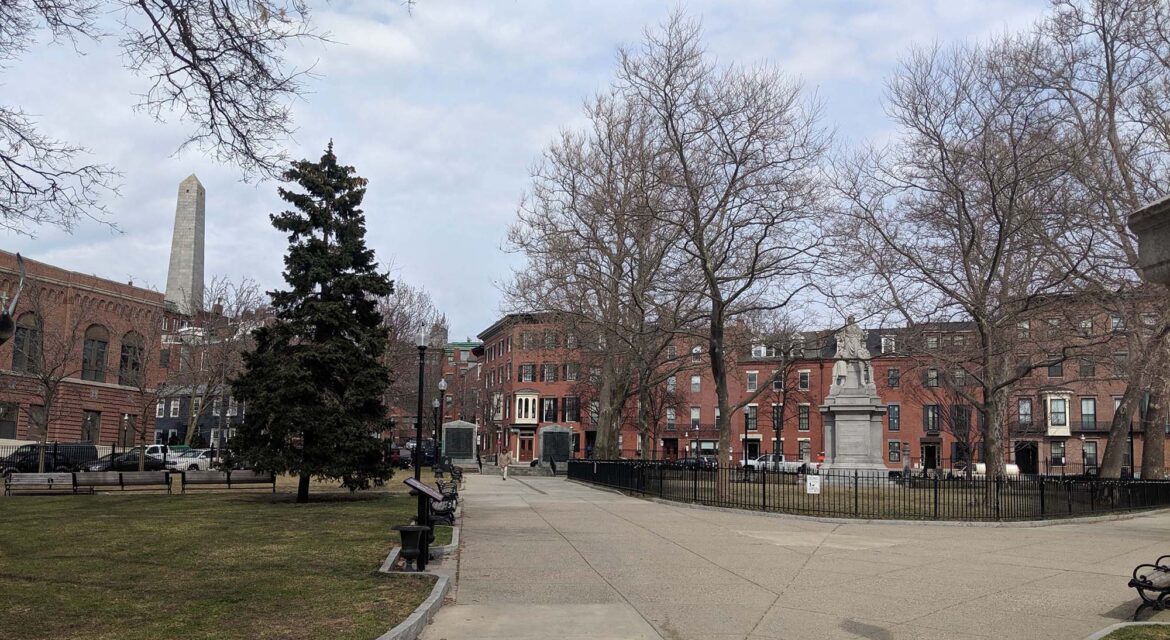 Utilizing the same field where colonial minutemen trained during the American Revolution, Winthrop Square features notable monuments that have been dedicated to soldiers from various wars who fell in battle. Located in Boston’s Charlestown neighborhood, the Square highlights what it can look like for an urban park to function as so much more than a simple green space.
Utilizing the same field where colonial minutemen trained during the American Revolution, Winthrop Square features notable monuments that have been dedicated to soldiers from various wars who fell in battle. Located in Boston’s Charlestown neighborhood, the Square highlights what it can look like for an urban park to function as so much more than a simple green space.

A Landscape of War and Commemoration
 What is now Winthrop Square was once a training field for American colonists, which is why it is still referred to as “Training Field”. The space began to be used for this purpose in the 1640s but it also played an active part in the American Revolution when Colonial troops marched to Charleston and likely through Training Field to prevent the advance of British soldiers on Breed’s Hill. The nearby Bunker Hill Monument commemorates this British attack that ended up being one of the most important events of the entire war.
What is now Winthrop Square was once a training field for American colonists, which is why it is still referred to as “Training Field”. The space began to be used for this purpose in the 1640s but it also played an active part in the American Revolution when Colonial troops marched to Charleston and likely through Training Field to prevent the advance of British soldiers on Breed’s Hill. The nearby Bunker Hill Monument commemorates this British attack that ended up being one of the most important events of the entire war.
After the Revolution, Training Field continued to function as a place for soldiers to gather, but the military stopped using it in the 1850s. It then became an urban park with the eventual inclusion of memorials that were dedicated to American servicemen.
The bronze Fallen Tablets were created in 1889 and feature the names of Colonial soldiers who fell in the Battle of Bunker Hill. However, the most notable element of the space is the granite Soldiers and Sailors Monument. Dedicated in 1872 to the soldiers who fought for the Union during the American Civil War, the monument is among the first examples of Civil War commemorative statuary and served as a model for many other war memorials. It features a female figure that represents America crowing a soldier and sailor with laurel wreaths.
The large green space in Winthrop Square allows visitors to enjoy these monuments but also actively enables experiences in the present. Training Field marks the end of the Bunker Hill Day parade, held every June since the Bunker Hill Monument was dedicated in 1843. These organized events along with the simple benches and pathways that the Square contains highlight what it means for a space to become something that can both define and enhance an entire community

Connecting the Past to the Present and Future
 There are plenty of Soldiers and Sailors monuments that are larger than the one in Winthrop Square, while other memorials feature a more complete listing of soldiers who fell in certain battles. Being featured in what would otherwise just be a bare green space has enabled Winthrop Square to become an “outdoor living room” for Charleston, where citizens regularly gather for everything from fairs to parades to memorial services.
There are plenty of Soldiers and Sailors monuments that are larger than the one in Winthrop Square, while other memorials feature a more complete listing of soldiers who fell in certain battles. Being featured in what would otherwise just be a bare green space has enabled Winthrop Square to become an “outdoor living room” for Charleston, where citizens regularly gather for everything from fairs to parades to memorial services.
In doing so, Winthrop Square showcases what it can mean to connect the past with the present and future of an entire community for the benefit of audiences across the eras.

